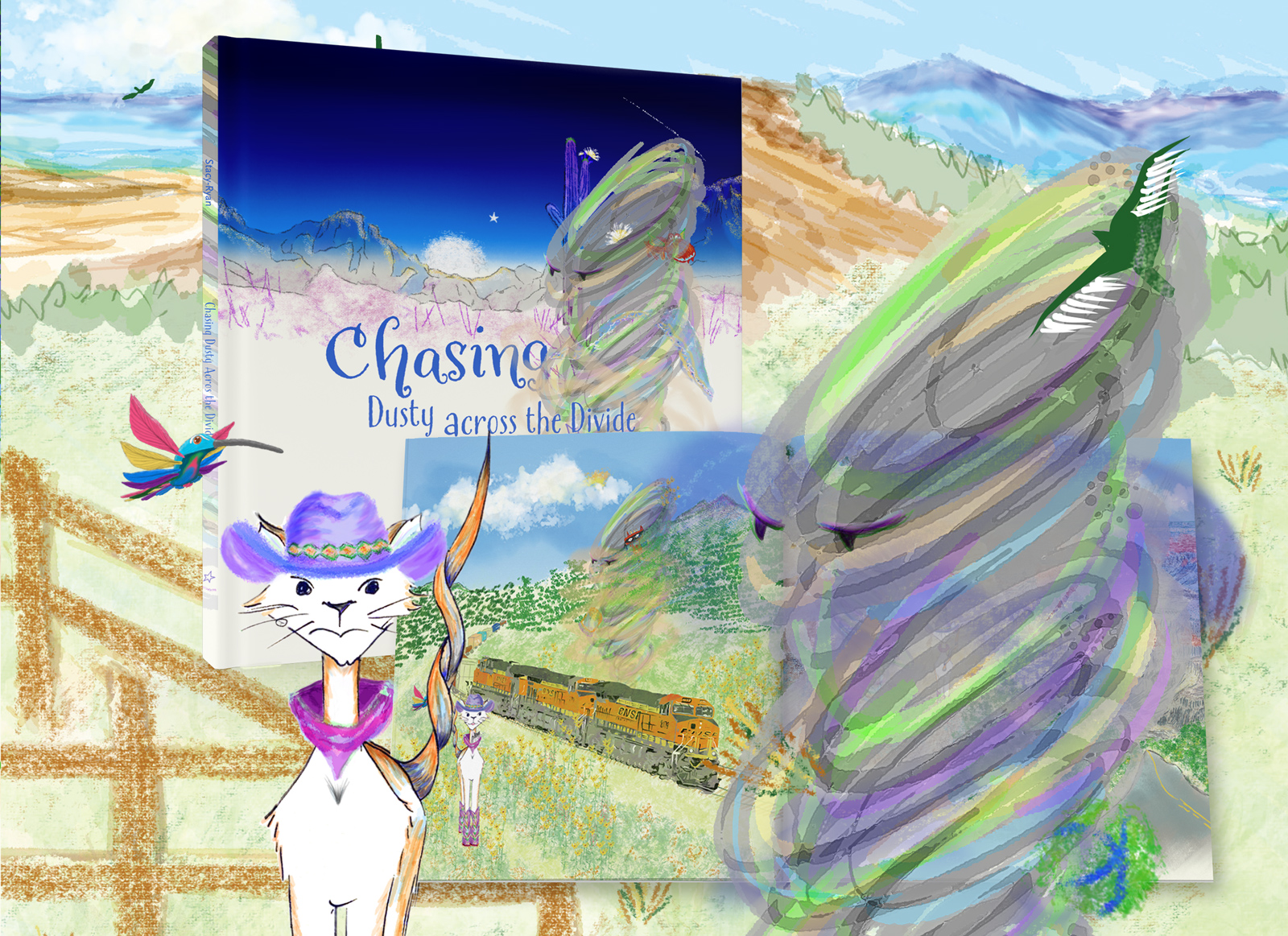Let’s Play and Learn
Chasing Dusty Across the Divide
From sunrise to sunset
across Arizona’s Divide
Bootzie and DeeDee chase Dusty.
Come along for the ride!

Let’s start with a jigsaw puzzle of the book’s cover.
The grid icon in the center of the puzzle lets you change how many pieces there are. Hit the OK to start the play.
Learn about Bootzie, DeeDee, Hank, and Dusty’s Arizona
Drag the name of the character over their picture.
Here are the Complete Footers:
Location 1
DUST DEVIL A small, brief whirlwind. They can reach several thousand feet high and last for over an hour with 60+ mph wind speeds. They can be destructive as they lift dust and other debris into the air.
HUMMINGBIRDS Many hummingbirds spend the winter in Central America or Mexico, and migrate north to their breeding grounds in the southern United States as early as February, and to areas further north later in the spring. Thirteen species are known to occur in the Chiricahuas and many migrate to northern Arizona. DeeDee heading north was a natural migration!
@Chiricahua Mountains, southeastern Arizona
Location 2
SONORAN DESERT A North American desert and ecoregion which covers large parts of the Southwestern United States in Arizona and California as well as Northwestern Mexico. It has an area of 100,000 sq. mi. It provides subtropical warmth in winter and two seasons of rainfall.
SAGUAROS (Carnegiea gigantea) are large, tree-like columnar cacti that develop branches (or arms) as they age, although some never grow arms. These arms generally bend upward and can number over 25. Saguaros are covered with protective spines, white flowers in the late spring, and red fruit in summer. They can only be found in the lush Sonoran Desert of Arizona, as well as our southern neighbor state of Sonora, Mexico, and in some areas of southeastern California.
@Sonoran Desert outside Phoenix, Arizona
Location 3
MONGOLLON RIM (MAA • guh • luhn • RIM) The Rim is an escarpment defining the southwestern edge of the Colorado Plateau, separating the Colorado Plateau and the Central Highlands and forms, in part, the divide between the Little Colorado River and Salt River drainage areas. Its central and most spectacular portions are characterized by high cliffs of limestone and sandstone, namely the Kaibab Limestone and Coconino Sandstone cliffs. It stretches 200 miles from Yavapai County to New Mexico. References for the Mongollon Rim: USGS | Wikipedia | Visit Arizona | US Forest Service | Where in Da World
@Mongollon Rim in eastern Arizona
Location 4
HIGH COUNTRY A nickname for the Colorado Plateau, including the towns of Flagstaff, Sedona, Prescott, and Payson in northern Arizona. While most people think of Arizona as a desert region, much of the state is actually mountainous high country. Rather than endless rugged mountain peaks, the high country is predominantly rolling plateaus. Reference for the Colorado Plateau: Museum of Northern Arizona
@East of Flagstaff, Arizona
Location 5
ARIZONA DIVIDE The tipping point where water will either run north or northwest into the Colorado River watershed or south or southwest into the Gila River watershed. The divide is for a short time only, as the Gila eventually flows into the Colorado near Yuma. Reference: Where Arizona rivers part ways
TRAINS THROUGH FLAGSTAFF The Atlantic and Pacific Railroad laid tracks through Flagstaff and the rest of northern Arizona and New Mexico in the 1880s. Flagstaff became part of a continuous rail connection between St. Louis and the Pacific Ocean. The BNSF Railway is among the top transporters of intermodal freight in North America. Amtrak Passenger Trains also run through the town.
SAN FRANCISCO PEAKS Three summits–Humphreys (12,635 feet, the highest point in Arizona), Agassiz, and Fremont peaks–on the rim of an eroded extinct volcano 10 miles (16 km) north of Flagstaff on the Colorado Plateau. San Francisco Mountain was once 2-4,000 feet higher, rising to a singular peak. More than 400,000 years ago, its top collapsed it erupted outwards towards the east. The mountain is of great spiritual significance to numerous Native American tribes including the Navajo and Hopi.
@The Arizona Divide, noted by Mile Marker 190 on I-40, west of Flagstaff
Location 6
MONSOONS Simply put, the monsoon is the time of the year, or the season, when winds shift, bringing an increase in moisture to the Southwest. The storms can range from minor blowing dust to severe thunderstorms. Often, the more severe storms begin with towering walls of dust hundreds of feet high that move across the Valley. These dust walls are known as “haboobs,” an Arabic term for the similar walls of dust that are common in the Middle East (Yes! Remember Haboob? See Chasing Dawn and the Sands of Time). With the dust comes high winds, usually followed by heavy rains.
RED MOUNTAIN A cinder cone in the San Francisco Volcanic Field about 25 miles northwest of Flagstaff, Arizona. It rises 1,000 feet above the surrounding landscape and is unusual in having the shape of a “U,” and in lacking the symmetrical shape of most cinder cones. A large natural amphitheater cuts into the cone’s northeast flank. Vertical erosional pillars called “hoodoos” decorate the amphitheater, and many dark mineral crystals erode out of its walls.
@Red Mountain off Highway 180
Location 7
GRAND CANYON The Grand Canyon of the Colorado River is a mile-deep canyon (1.6 km). Grand Canyon National Park encompasses 277 river miles (446 km) of the Colorado River and adjacent uplands. The park is home to much of the immense Grand Canyon, in some stretches, up to 18 miles (29 km) wide. Layered bands of colorful rock reveal millions of years of geologic history.
SOUTH RIM OF GRAND CANYON Averages 7,000 feet/2134 m above sea level. The main entrance is about 75 miles from Flagstaff. As you approach, you have no warning about the majestic landscape you are about to see.
@South Rim of Grand Canyon
Location 8
NORTH RIM Over 8,000 feet/2438 m. in elevation. The North Rim of the park, which lies just 10 miles (16 km) across the canyon from the South Rim, (as the California condor flies) but is a 220 mile/ 354 km drive by car if you drive “around” through Lees Ferry. The North Rim has a short season. Lodging and food services are open between May 15th and October 15th of each year, and it is closed to all vehicles between December 1st and May 15th. Reference: National Park Service
@North Rim of Grand Canyon

